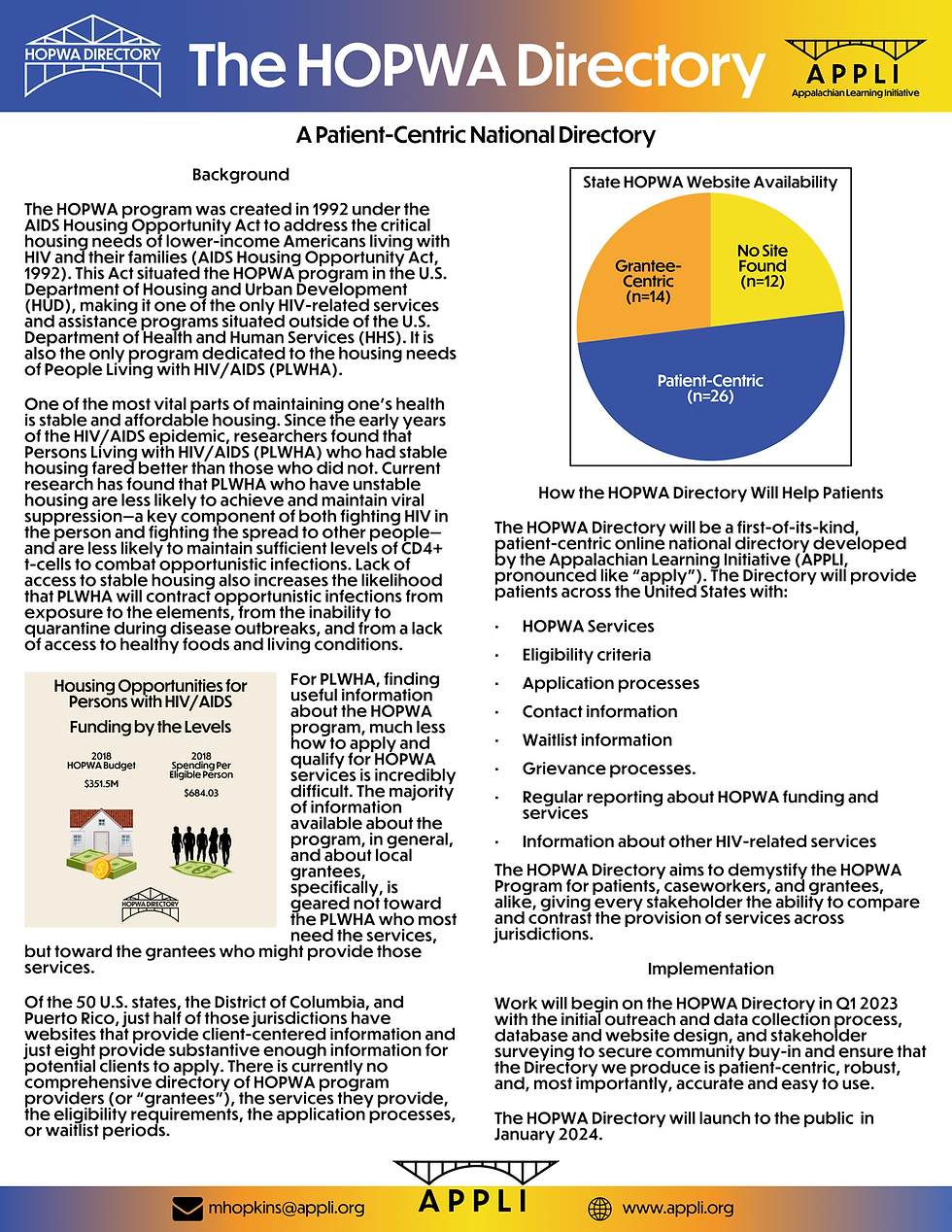The Importance of HOPWA in Appalachia
- Marcus J. Hopkins
- Dec 6, 2022
- 3 min read

By: Marcus J. Hopkins
December 6th, 2022
With the Appalachian Learning Initiative's recent announcement that we will be expanding our programming to include a first-of-its-kind national digital directory for the Housing Opportunities for Persons with HIV/AIDS (HOPWA) program, APPLI has taken an important first step toward advocating for better access to supportive social services in Appalachia and across the United States.
About the HOPWA Program
For the uninitiated, the HOPWA program was created in 1992 under the AIDS Housing Opportunity Act to address the critical housing needs of lower-income Americans living with HIV and their families. It is the only federal program dedicated to the housing needs of People Living with HIV/AIDS (PLWHA).

Despite the critical need for stable housing for PLWHA, funding for the HOPWA program for the 2017-2018 Fiscal Year was just $351.5 million.
If all 513,868 PLWHA who were eligible had received housing assistance from the HOPWA program, this budget allocation would have come out to a total expenditure of just $684.03 per person per year.
Unfortunately, because the HOPWA program has been critically underfunded for the entirety of its existence, the program was able to serve just 9.8% of those eligible—50,310 households in 2017-2018.
In the 2020-2021 Fiscal Year, 54.49% of HOPWA-eligible individuals served were Black Americans, 37.13% were White, and 5.37% were Other/Multi-Racial. Across all races, 19% of HOPWA-eligible individuals identified as Latino/Hispanic.
The Importance of Stable Housing in HIV Care
As with every facet of life, the need for stable housing is often the driving force behind our sense of security, our ability to maintain a standard of living, and our ability to remain healthy. For PLWHA, having stable housing can mean the difference between achieving and maintaining viral suppression and going untreated. Current research has found that PLWHA who have unstable housing are less likely to achieve and maintain viral suppression—a vital component of both fighting HIV in the person and fighting the spread to other people—and are less likely to maintain sufficient levels of CD4 t-cells to combat opportunistic infections. Lack of access to stable housing also increases the likelihood that PLWHA will contract opportunistic infections from exposure to the elements, from the inability to quarantine during disease outbreaks, and from a lack of access to healthy foods and living conditions.

How the HOPWA Program Impacts Appalachians
The story of the HOPWA program in Appalachia is one of limited access, opaque processes, and mixed results. Part of what inspired APPLI to select the HOPWA Directory as one of our programmatic offerings was a lapse in service provision from one of West Virginia's HOPWA grantees and the inability of patients and Ryan White caseworkers to resolve those issues effectively due to unclear procedures for HOPWA clients to file grievances against HOPWA grantees and because no one knew who to call to resolve these issues once the grantee stopped responding.
Appalachia is home to some of the poorest counties in the United States and, in recent years, to some of the counties with the highest rates of new HIV diagnoses in the nation. 45 of Appalachia's 131 jurisdictions have rates of new HIV diagnoses above the national rate of just 9.2 (per 100k). In 2020, Cabell County, West Virginia, had the highest rate of diagnoses in the U.S., with a rate of 85.0 new diagnoses per 100,000 residents.

The intersection of both high levels of poverty and the incidence of new HIV diagnoses in lower-income Appalachians means that the HOPWA program is a vital component for ending the HIV epidemic through viral suppression, both in terms of better health outcomes for PLWHA and as it relates to being undetectable and therefore unable to transmit HIV to serodiscordant partners.

As we look forward to beginning work on the HOPWA Directory in 2023, we will continue our vital research and reporting on Adult Literacy and Numeracy issues in Appalachia.
Our expansion into the Public Health space does not mean that our dedication to those issues will lessen or falter. Rather, we fervently believe that they are inherent components of why Appalachian residents experience worse health outcomes than other Americans.
And, as with health outcomes, stable housing directly impacts educational attainment and outcomes. When we address one issue, we are impacting several.
Check out our one-pager on the HOPWA Directory to learn more:

.png)




Comments